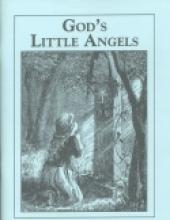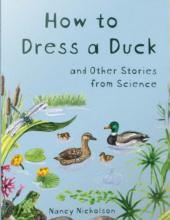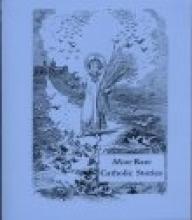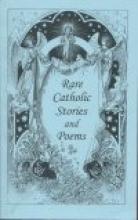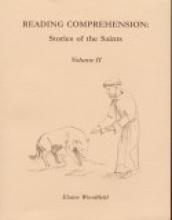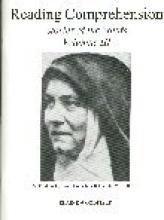Language Arts Reading Comprehension
God's Little Angels
This lovely story is reprint of the 1905 book The Transplanting of Tessie. Little Tessie spent six years at a convent boarding school before becoming ill. She finds herself at her uncle's country estate where she recovers and, through many adventures, brings her relatives to the Catholic faith. All of our children enjoyed this touching story. The author writes vividly and with just enough suspense to keep the reader wanting more. Each chapter is followed by a set of comprehension questions (answers at the back of the book) for those who want to use the book as part of their schoolwork. Although I read this story aloud to our children it is also suitable for mature 5th graders and older to read alone. Younger children will enjoy hearing the story and will benefit from having some of the older customs mentioned in the book explained to them. The softcover on this 8 ½" x 11" book is easily torn so owners may want to cover it with clear contact paper before passing it on to their children to read.
Copyrights 1905/1998
Heroes of God's Church
I think the author does an admirable job in achieving his purpose. We are shown how the Saints were real people who struggled with things like bad tempers and parents who just didn't understand their religious fervor. Some became great saints by just doing the little everyday things well and out of love while others showed incredible heroism through the most agonizing tortures and martyrdom.
The book covers 25 Saint stories, from 6 to 18 pages each, with comprehension questions for each story. We are presented with a variety of Saints of every age with a true diversity of personalities, difficulties to overcome and social classes. The chronological order and selection would also make this a very worthwhile supplement to a study of World History.
The comprehension questions seem suited to mid-grade school (perhaps grades 3-6) but the stories themselves would be appropriate for a wide age range (probably from first grade through adult if care is taken with regard to some of the "scarier" martyr stories for the very young ones).
How to Dress a Duck and Other Stories from Science
This book offers thirty-six stories about God's amazing world that very nicely brings science back to its creator and helps children make connections between faith and reason. We've had the earlier edition of this book for a number of years and I have found many tidbits about nature that were new and very interesting to me - especially information about why God made things the way that he did and what is good and useful about his creation.
This new edition includes many new stories and looks more like a grade school workbook - in size and appearance as well as having space for the students to answer the chapter questions right in the book. In addition to the Catholic content I really like this book because 1. it is loaded with interesting content, 2. it is written in an appealing story-like format, 3. it is not "dumbed-down" or written in a condescending tone like so many textbooks. Here's a brief excerpt to give you a sense of the style and content:
"God has a similar system for supplying water to places that don't get much rain in the summer. Instead of a freezer, God uses tall, snow-covered mountains to store up icy snow. In some mountain ranges, like the Rocky Mountains that stretch north and south across Canada and the United States, peaks often receive thirty or forty feet of snow each year. That is nearly enough snow to bury a Ferris wheel! Even after winter has passed, the cool mountain air allows the snow to melt very slowly. Melting snow slips into creeks and rivers that carry needed water to farms and cities far away. Some of those farms and cities don't get much rain in the summer. Some of them don't even have snow in the winter. But the people who live there are happy to drink and swim in the water that came from God's faraway frozen mountains." (from "Merciful Rain" pgs. 59-61)
This book can be used as a science supplement or as a non-fiction reading comprehension workbook.
More Rare Catholic Stories and Poems
This second volume of stories is very similar to the first. Volume 2 is a larger book (7" x 8") and geared for slightly older children.
Rare Catholic Stories and Poems
Make sure you have a hankie close by when you read these books. These faith inspiring stories surely must have contributed to the steadfastness that Catholic children displayed years ago. The stories in both volumes include main characters that are young and old, male and female thus appealing to everyone. Each story is short enough to be read by an average 4th grader in five to ten minutes. Follow up comprehension questions range from simple recall to more the more thought provoking type that would open the door to many wonderful parent child discussions. We had our children read this book straight through as their spiritual reading and at a later time had them read some of the stories again and work through the comprehension questions. This book would also serve well as a source for bedtime stories or for poetry memorization. Volume 1, which is suitable for grade 3 and up, is a small softcover book 5½" x 8½" and includes several illustrations for each story.
Reading Comprehension: Stories of the Saints, Volume 1
Ten Saint stories are told in an engaging manner for children (recommended for mid-grade schoolers): St. Maria Goretti, St. Maximillian Kolbe, St. Catherine Laboure, St. Bernadette Soubirous, Blessed Miguel Pro, St. Martin De Porres, St. John Bosco, St. Francesca Cabrini, St. Philomena, and Blessed Herman of Reichenau. Each story is approximately 6 - 8 pages long and is illustrated with pen and ink drawings. The Reading Comprehension portion for each story includes vocabulary words, study questions and a number of projects relating to the saint such as - memorizing special quotes from the saint, researching a report relating to the saint, illustrating scenes from the story or studying some of the geography of where the saint lived and worked. The stories are beautiful and inspiring and cover both very familiar saints and some more obscure ones. My very favorite (whom I had never heard of before) was Blessed Herman of Reichenau - a severely crippled monk (with a brilliant mind) who lived in the Middle Ages and composed the Salve Regina (Hail Holy Queen). A complete answer key is found in the back of the book.
Reading Comprehension: Stories of the Saints, Volume 2
This book provides twelve engaging saint stories (four to nine pages each) with a page or so of vocabulary words, comprehension questions, quotes from the saint and project ideas. Saints covered in this volume are: Saint Faustina Kowalska, Saint Juan Diego, St. Rose of Lima, St. Francis of Assisi (in two parts), Rose Hawthorne Lathrop, Venerable Fr. Solanus Casey, St. Helena, Blessed Fr. Damien of Molokai, St. Elizabeth of Hungary, St. Ambrose and Mother Seton.
The stories are nice enough to make this a stand alone book of saint stories even without the reading comprehension sections. Mrs. Woodfield has a way of including the most interesting details about the saints that I haven't seen elsewhere. Most stories are illustrated with pen and ink drawings, while modern Saints are illustrated with black and white photos. A complete answer key is included.
Copyrights 1998/2002
Reading Comprehension: Stories of the Saints, Volume 3
The ad for this book does not do it justice. It is far more than just a reading comprehension workbook and although the ad does list the activities involved, it doesn't express their depth or breadth. This book could be used as a unit study! I plan to have my 12 year old select a saint each quarter to prayerfully study and to immerse himself in the saints life and spirituality. Although Isaiah enjoys reading the lives of the saints, when he's done with a book (usually in a few days) his devotion to the saint usually doesn't last long. I think the activities in this book are outstanding for helping the students really love the saint.
The stories are long (about 25 pages on 8x11" pages long with nice photographs) The lesson activities begin with vocabulary words which the kids should review before they begin the story. Then there are a host of different activities, but only the first set of questions are typical "comprehension" questions. Even then they pull the reader in to focus on key points. After the comprehension questions come the part of the lesson activities that are unique and bring the saint to life. "Analyze this" has 5 or 6 questions such as this "How did Gianna take steps to resolve her vocation question? The "Essay Questions" (10 or so) are similar to this "How did the resolutions Gianna made from her retreat change her life?" Next are the "Quotations" (3 or 4) that the children are encouraged to memorize, reflect on and recite. After that comes "Geography and History" activities (about 5) which focus on where the person lived and what was going on in their life at that time. "Research and Report" offer around 4 topics for the student (eg. research and write about Lay Franciscans.) "Write your own Biography" varies between stories. Finally "Putting Your Faith Into Practice" has 3 questions. The following is just one part of one question: "Point for point, comment on Gianna's retreat resolutions......"
Reading Comprehension: Stories of the Saints, Volume 3
This book contains four in-depth saint stories (approximately 25 pages each): St. Edith Stein, Blessed Gianna Molla, Blessed Father Francis Xavier Seelos, C.Ss.R and Blessed Junipero Serra. The stories are very nicely told, with all the interesting tidbits that people love to read about. Mrs. Woodfield likes to catch the reader's attention by starting out at a particularly interesting part of the story and "leave you hanging" while she goes back to the childhood and upbringing of the saint (or blessed) in question. These are great stories, and the first two in particular are enhanced by a number of black and white photographs.
Saint Edith Stein (1891-1942) was a German Jew-turned-atheist who converted to the Catholic faith in 1922. In 1933 she entered the Carmelite Convent in Cologne Germany, but later was moved to Holland because of the danger from the Nazis. In 1942, Dutch Catholic Bishops spoke against the Nazis treatment of the Jews. The Nazis took revenge by rounding up Catholics of Jewish ancestry and sending them to concentration camps. Saint Edith Stein died at Auschwitz in August of 1942.
Blessed Gianna Beretta Molla (1922-1961) was an Italian doctor and mother of three children when she learned she was expecting her fourth child. It was discovered that a large tumor was growing in her womb during pregnancy. This required surgery but posed several options: 1. remove the tumor and the womb, ending the life of the unborn child (the "safest" option for Gianna herself), 2. remove the tumor and the unborn baby (without removing the womb - allowing possible future pregnancies, but still ending the life of the child), 3. remove the tumor, but allow the baby to come to full term and live (posing the danger of complications during childbirth because of the surgery). Gianna chose the third option.
Blessed Father Francis Xavier Seelos C.Ss.R. (1819-1867) was a Bavarian-born Redemptorist priest who faithfully served as a parish priest, pastor, and seminary instructor in various parts of the United States. While in Pittsburgh, Pennsylvania (with St. John Neumann as a superior), he contended with the anti-Catholic Know-Nothings while ministering to his parishioners, teaching catechism and providing a worthy example to many. He also worked in Maryland and Louisiana. This story would make an interesting Catholic addition to the study of American History.
Blessed Father Junipero Serra (1713-1784) is the well known Franciscan priest who founded the California missions - Catholic centers of evangelization, worship, education and protection for the local natives of California.
Saint stories are the ultimate antidote to modern culture. Average Americans today are bombarded with television commercials which not only try to persuade them to buy particular things, but generally help them to develop the mindset that material things will make them happy. Saint stories are about happiness too. They show us that a certainly earthly happiness (and true happiness in the long run) can come from living according to an idea that is very foreign to modern culture. Material goods are never truly satisfying. They only create a desire for more. A love for God and a life of service toward others, while more challenging, is also much more rewarding.
This book is recommended for seventh grade, but could be read aloud to younger children and would be suitable for high school and adult levels as well. Each story includes a very extensive section of Lesson Activities from which comprehension questions, vocabulary and a wealth of other projects and exercises can be chosen to reinforce the story and develop comprehension skills. A complete answer key is provided in the back of the book.

